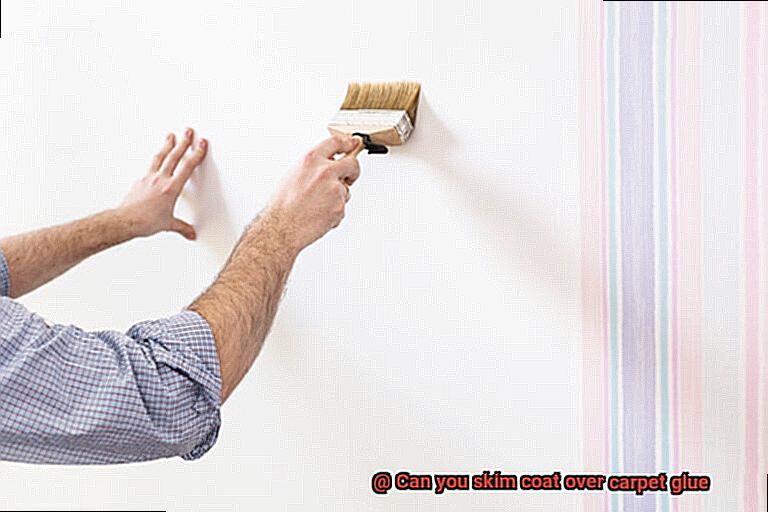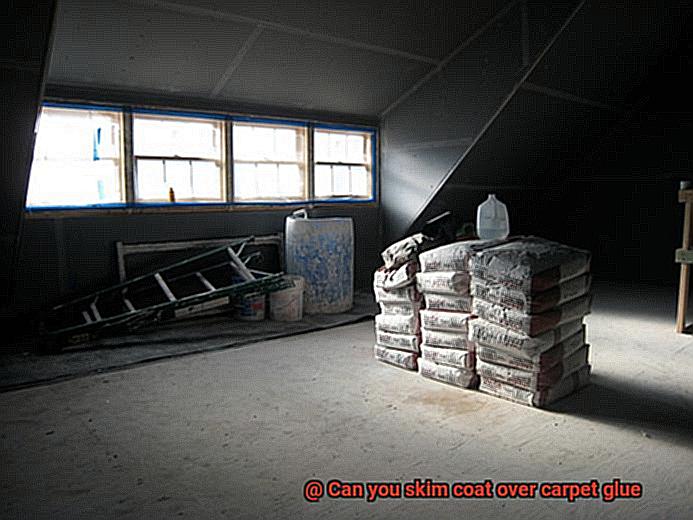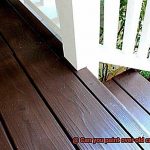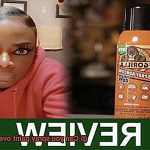Are you looking to spruce up your living space with a fresh new look? Well, you might have hit a bump on the road while removing old carpeting and discovering some stubborn carpet glue that just won’t budge. But don’t worry, we’ve got your back. The question that’s been nagging at you is whether skim coating over carpet glue is possible.
Skim coating has become quite popular for smoothing out surfaces before painting or installing new flooring. However, if you’re new to the process, it’s easy to assume that skim coating over carpet glue is impossible due to its strong adhesion to the surface.
But here’s the good news – it’s not impossible. In this blog post, we’ll delve into this question and explore whether you can successfully skim coat over carpet glue. We’ll also discuss the challenges homeowners face when attempting to do so and provide effective methods for removing the pesky glue. Plus, we’ll give you step-by-step instructions on how to skim coat over carpet glue if that’s what you choose to do.
So, are you ready for an exciting journey of discovery? Let’s dive in and find out if skim coating over carpet glue is feasible.
Types of Carpet Glue
Contents
- 1 Types of Carpet Glue
- 2 Testing Adhesion of Carpet Glue
- 3 Pros and Cons of Skim Coating over Carpet Glue
- 4 Preparing the Surface for Skim Coating
- 5 Applying the Skim Coat Mixture
- 6 Finishing Touches for a Smooth Surface
- 7 Common Mistakes to Avoid When Skim Coating Over Carpet Glue
- 8 Alternative Solutions to Skim Coating Over Carpet Glue
- 9 Conclusion

Installing new carpeting can be an exciting project, but choosing the right type of carpet glue is essential for a successful installation. Let’s explore the various types of carpet glue available and their unique advantages.
Latex Carpet Glue
This type of glue is perfect for residential installations due to its ease of application, quick drying time, and water-resistant properties. It’s an ideal choice for DIYers as it’s straightforward to use and doesn’t produce noxious fumes.
Polyurethane Carpet Glue
For maximum strength and durability, polyurethane carpet glue is an excellent option. It creates a powerful bond between the carpet and subfloor and can withstand heavy foot traffic. However, it emits toxic fumes during application and requires proper ventilation.
Acrylic Carpet Glue
Acrylic carpet glue is perfect for high-traffic areas such as schools, hospitals, and offices because of its impressive strength and resistance to wear and tear. It’s also water-resistant and easy to clean, making it ideal for busy environments.
Pressure-Sensitive Carpet Glue

This type of glue simplifies the installation process by allowing you to reposition the carpet if necessary. It’s also easy to remove if needed, making it an excellent choice for temporary installations or frequent carpet replacements.
When selecting a carpet glue, consider factors such as durability, ease of application, water-resistance, and toxicity levels. Ensure that you choose the right type of adhesive based on your specific project needs and requirements.
It’s vital to test the adhesive adhesion before proceeding with any project as some types of carpet glue may require removing the entire carpet layer before applying a new surface layer.
Testing Adhesion of Carpet Glue
Before you get started, it’s important to ensure that the glue used to secure the carpet has strong adhesion properties. Testing the adhesion of carpet glue is a crucial step in determining whether it is possible to achieve a smooth, even finish with skim coating.
Skim coating is the process of applying a thin layer of joint compound or plaster over a surface, creating a flawless finish. However, if the carpet glue does not adhere properly to the surface, the skim coat will not bond well and may crack or peel over time. This is where testing comes in.
One way to test the adhesion of carpet glue is by performing a simple peel test. By cutting a small section of carpet glue with a sharp utility knife and then attempting to peel it off with a putty knife or scraper, you can determine whether the glue is suitable for skim coating. If it comes off easily and cleanly, it may not be strong enough for skim coating. On the other hand, if it’s difficult to remove and leaves behind a strong adhesive residue, it may be possible to skim coat over it.
Another method of testing adhesion is the pull-off test, which involves using a specialized instrument to apply a controlled force to the surface of the carpet glue and measuring the amount of force required to pull it off. This test provides more precise results and can help determine whether the glue has enough bonding strength for skim coating.
However, it’s important to remember that different types of carpet glue may have varying adhesion properties and may require different testing methods. Additionally, environmental factors such as temperature, humidity, and surface preparation can also affect adhesion and should be taken into account when testing carpet glue for skim coating.
Pros and Cons of Skim Coating over Carpet Glue
One major advantage of skim coating over carpet glue is its ability to save both time and money. By eliminating the need to remove the old adhesive entirely before applying a new layer of coating, you can significantly reduce the time and cost associated with the project.
Additionally, skim coating can improve adhesion between the flooring and the new coat, resulting in a smoother and more durable surface that is better suited for new flooring. Skim coating also provides a level surface by evening out any bumps or dips in the existing flooring, creating a solid base for installation.
However, there are also some potential disadvantages to consider. One challenge is achieving a uniform thickness when applying the skim coat. If applied unevenly, it can result in an uneven surface that may require additional work to correct.
Another potential issue is that certain types of carpet glue may not adhere well to the skim coat, leading to peeling or delamination of the new layer. In some cases, additional preparation such as sanding or grinding may also be necessary before applying the skim coat, adding to the overall time and cost of the project.
It’s important to carefully weigh these pros and cons before deciding whether skim coating over carpet glue is the right choice for your specific situation. A professional contractor can assess the condition of your existing flooring and offer recommendations on whether this option is viable.
Preparing the Surface for Skim Coating
While this can be a great option, it’s important to properly prepare the surface to ensure a smooth and even finish. As an expert in preparing surfaces for skim coating, I’m here to share some tips and tricks to make your project a success.
The first step is to test the carpet glue for any adverse reactions with the skim coat material. This crucial step can prevent an uneven finish or even failure of the skim coat altogether. To test, apply a small amount of skim coat material to a small section of the floor and observe any changes or reactions over time.
Assuming there are no adverse reactions, the next step is to thoroughly clean the surface. Use a vacuum cleaner or scraper to remove any debris or loose material, ensuring that the skim coat has a clean and level surface to adhere to.
After cleaning, it’s important to fill any gaps or cracks with a suitable filler material. This ensures that the surface is level and smooth before applying the skim coat. Don’t skip this step as it can lead to an uneven finish.
Finally, applying a primer before applying the skim coat is highly recommended. This helps improve adhesion and ensures a strong bond between the surface and the skim coat material. Skipping this step can result in poor adhesion, leading to an uneven finish.
To summarize:
- Test for adverse reactions between carpet glue and skim coat material
- Thoroughly clean the surface
- Fill any gaps or cracks with filler material
- Apply primer before applying the skim coat

Applying the Skim Coat Mixture
A skim coat may be the solution you need to achieve a smooth and even finish. As an expert in applying the skim coat mixture, let me guide you through the process with skill and precision.
Preparing the surface is crucial to ensure a successful outcome. Begin by cleaning the area thoroughly, removing any loose debris or dirt. If the carpet glue is particularly stubborn, use a scraper or chemical solvent to remove it completely. Once the surface is clean and free of any debris, prime the area with a high-quality primer.
Now comes the fun part – applying the skim coat mixture. You can use a trowel, roller, or spray gun depending on the size and complexity of the area being covered. Remember to apply the skim coat in thin, even layers to ensure a smooth and consistent finish. Multiple coats may be necessary depending on the condition of the surface being covered.
After each layer has been applied, allow ample time for it to dry completely before moving on to the next step in the process. Once all layers have been applied and allowed to dry, lightly sand the surface for an even smoother finish. Finally, paint or finish according to your desired aesthetic.
Finishing Touches for a Smooth Surface
In our previous section, we learned about transforming rough surfaces into masterpieces. Today, we’re taking it up a notch and exploring the essential finishing touches needed when skim coating over carpet glue.
The first step to achieving a smooth surface is sanding. Once the skim coat has dried, take some time to sand down any rough spots or imperfections. Sanding helps create an even surface that’s ready for painting or other finishing touches.
Choosing a high-quality primer is also crucial. A good primer seals the skim coat and creates a smooth surface for painting or other finishing products. Be sure to select a primer that’s compatible with both the skim coat and other products you plan to use.
But wait, there’s more. Applying a thin coat of joint compound or spackle over the skim coat before painting can help fill in any small imperfections and create an even smoother surface. Using a squeegee or trowel during application also helps create a smoother finish than using a roller or brush.
Finally, following manufacturer instructions when applying and finishing your skim coat is crucial in achieving the best possible results. Pay attention to details, and ensure each step is followed meticulously.
Common Mistakes to Avoid When Skim Coating Over Carpet Glue
A skim coat may be just what you need. However, before diving in headfirst, it’s crucial to understand the common mistakes people make when skim coating over carpet glue. Avoiding these pitfalls will save you time and ensure that your hard work pays off with a smooth, even surface.
Firstly, not preparing the surface properly is a recipe for disaster. Loose carpet fibers, dirt, and debris must be removed before applying the skim coat. Neglecting this step will result in an uneven surface, causing the skim coat to fail eventually.
Another common mistake is applying too much skim coat in one go. The result is an excessively thick layer that takes longer to dry and may crack or peel over time. Instead, apply multiple thin layers, allowing each layer to dry completely before adding another.
Using the wrong tools can also spell disaster when skim coating over carpet glue. A trowel or a wide putty knife is essential for applying the skim coat evenly and smoothly. Using a roller or brush can lead to an uneven surface with visible streaks or marks.
Lastly, don’t rush the drying process. While it may be tempting to speed things up with a fan or heater, this can cause the skim coat to dry too quickly and ultimately crack or peel. Give each layer of skim coat enough time to dry completely before adding another or walking on the surface.
Alternative Solutions to Skim Coating Over Carpet Glue
There are alternative solutions available that can help you achieve a smooth and level surface without removing the glue completely.
One such solution is using a self-leveling compound. This cement-based mixture can be poured over the carpet glue and left to dry. Once dry, it creates an even and sturdy surface that can serve as a base for new flooring. However, keep in mind that self-leveling compounds are only suitable for smaller areas and may not be the best solution for larger spaces.
Another option is to install a subfloor over the existing flooring. This involves laying down sheets of plywood or OSB over the carpet glue. The subfloor provides a stable and level surface for new flooring to be installed on top of. However, it’s important to ensure that the subfloor is securely fastened to the existing floor and that any gaps or seams are properly sealed.
If these solutions don’t work for your situation, removing the carpet glue may be necessary. This can be done through scraping, sanding, or using chemicals. But remember to take all necessary safety precautions and ensure proper ventilation when working with chemicals.
In summary, there are various alternative solutions available beyond skim coating over carpet glue. When selecting the best option for your needs, consider factors such as space size, subfloor type, and safety precautions. Proper preparation is key in achieving a smooth and even surface for your new flooring project.
rzc0uugAmYU” >
Conclusion
In conclusion, transforming your living space by removing old carpeting and tackling stubborn carpet glue is possible with skim coating. This popular technique smooths out surfaces before painting or installing new flooring, but it’s easy to assume that it won’t work over strong adhesive.
Before proceeding with any project, it’s important to test the adhesive adhesion. Certain types of carpet glue may require removing the entire carpet layer before applying a new surface layer. Simple peel tests or pull-off tests can help determine if skim coating is feasible.
Skim coating over carpet glue has its pros and cons. One major advantage is saving time and money by avoiding complete removal of the old adhesive. However, achieving uniform thickness when applying the skim coat can be challenging, and some types of carpet glue may not adhere well to the skim coat.
Proper preparation is key in achieving a smooth and even finish when skim coating over carpet glue. This includes testing for adverse reactions between materials, thoroughly cleaning the surface, filling gaps or cracks with filler material, and applying primer before the skim coat.
If you’re hesitant about skim coating over carpet glue, other solutions are available such as self-leveling compound or installing a subfloor over existing flooring. Ultimately, selecting the best option depends on factors such as space size, subfloor type, safety precautions, and proper preparation.






